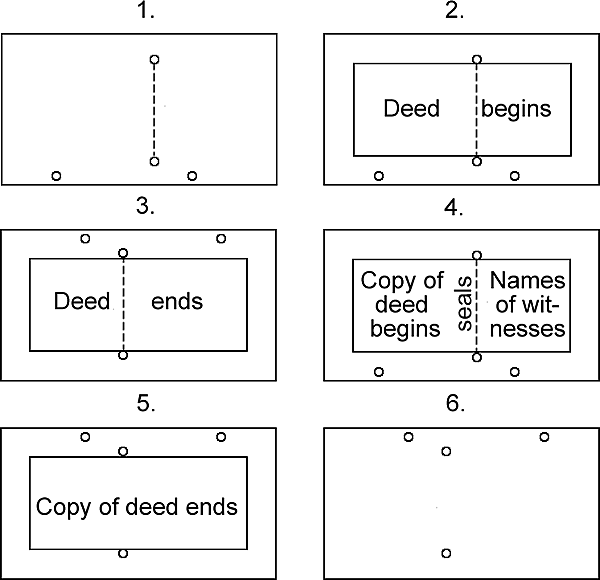
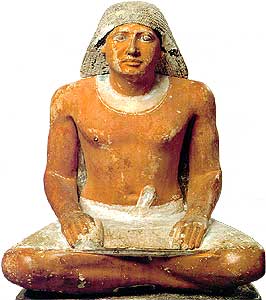
Of the various materials which have been used within the memory of man to receive writing, there are three, viz. papyrus, vellum, and paper, which, from their greater abundance and convenience, have, each one in its turn, displaced all others. But of the other materials several, including some which at first sight seem of a most unpromising character, have been largely used. For such a purpose as writing, men naturally make use of the material which can be most readily procured, and is, at the same time, the most suitable. If the ordinary material fail, they must extemporize a substitute. If something more durable is wanted, metal or stone may take the place of vellum or paper. But with inscriptions on these harder materials we have, in the present work, but little to do. Such inscriptions generally fall under the head of epigraphy. Here we have chiefly to consider the softer materials on which handwriting, as distinguished from monumental engraving, has been wont to be inscribed. Still, as will be seen in what follows, there are certain exceptions ; and to some extent we shall have to inquire into the employment of metals, clay, potsherds, and wood, as well as of leaves, bark, linen, wax, papyrus, vellum, and paper, as materials for writing. We will first dispose of those substances which were of more limited use.
↑top
It is natural to suppose that, in a primitive state of society, leaves of plants and trees, strong enough for
the purpose, would be adopted as a ready-made material provided by nature for sack an operation as writing. In various parts of India and the Bast the leaves of palm-trees have been in use for centuries, and continue to be employed for this purpose, and form an excellent and enduring substance. Manuscripts written on palm-leaves have been of late years found in Nepaul, which date back many hundreds of years. In Europe leaves of plants are not generally of the tough character of those which grow in the tropics ; but there can be no doubt that they were used in ancient Greece and Italy, and that the references by classical writers to their employment are not merely fanciful. There is evidence of the custom of πεταλισμός, or voting for ostracism with olive-leaves, at Syracuse, and of the similar practice at Athens under the name of έκφυλλοφορία. Pliny, Nat. Hist. xiii. 11, writes: "Antea nou fuisse chartarum usum : in palmarum foliis primo scriptitatum, deinde quarundam arborum libris."
↑top
Better adapted for writing purposes than leaves was the bark of trees, liber, which we have just seen named by Pliny, and the general use of which caused its name to be attached to the book (i.e. the roll) which was made from it. The inner bark of the lime-tree, φιλύρα, tilia, was chosen as most suitable. Pliny, Nat. Hist. xvi. 14, describing this tree, says: " Inter corticem et lignum tenues tunicas sunt multiplici membrana, e quibus vincula tiliae vocantur tenuissimae earum philyrae." It was these delicate shreds, philyrae, of this inner skin or bark which formed the writing material. In the enumeration of different kinds of books by Martianus Capella, ii. 136, those consisting of lime-bark are quoted, though as rare : " Rari vero in philyrae cortice subnotati." Ulpian
also, Digest, xxxii. 52, mentions " volumina ... in philyra aut in tilia." But not only was the bark of the lime-tree used,but tablets also appear to have been made from its wood—the "tiliae pugillares" of Symmachus, iv. 34; also referred to by Dio Cassius, lxxii. 8, in the passage: " δώδεκα γραμματεῖα οἶά γε έκ φιλύρας ποιεῖται." It seems that rolls made from lime-bark were coexistent at Borne with those made from papyrus, after the introduction of the latter material; but the homemade bark must soon have disappeared before the imported Egyptian papyrus, which had so many advantages both in quantity and quality to recommend it.
↑top
Linen cloth, which is found in use among the ancient Egyptians to receive writing, appears also as the material for certain rituals in Roman history. Livy, x. 38, refers to a book of this character, " liber vetus linteus," among the Samnites; and again, iv. 7, he mentions the "lintei libri" in the temple of Moneta at Rome. Pliny, Nat. Hist. xiii. 11, names " volumina lintea" as in use at an early period for private documents, public acts being recorded on lead. Martianus Capella, iii. 136, also refers to " carbasina volumina"; and in the Codex Theodos. xi. 27, 1, " mappae linteae" occur.
↑top
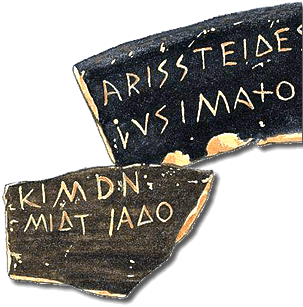
Clay was a most common writing material among the Babylonians and Assyrians. The excavations made of late years on the ancient sites of their great cities have brought to light a whole literature impressed on sun-dried or fire-burnt bricks. Potsherds came ready to the hand in Egypt, where earthenware vessels wore the most common kind of household utensils. They have been found in large numbers, many inscribed in Greek with such ephemeral documents as tax and pay receipts, generally of the period of the Roman occupation. To such inscribed potsherds has been given the title of ostraka, a term which will recall the practice of Athenian ostracism
in which the votes were recorded on such fragments. That such material was used in Greece only on such passing occasions or from necessity is illustrated by the passage in Diogenes Laertius, vii. 174, which narrates that the Stoic Cleanthes was forced by poverty to write on potsherds and the shoulder-blades of oxen. Tiles also, upon which alphabets or verses were scratched with the stilus before baking, were used by both Greeks and llomans for educational purposes.
↑top
It is perhaps straining a term to include the walls of buildings under the head of writing materials; but the graffiti or wall-scribblings, discovered in such large numbers at Pompeii, hold such an important place in the history of early Latin palaeography, that it must not be forgotten that in ancient times, as now, a vacant wall was held to be a very convenient place to present appeals to the public, or to scribble idle words.
↑top
The precious metals were naturally but seldom used as writing materials. Por such a purpose, however, as working a charm, an occasion when the person specially interested might be supposed not to be too niggard in his outlay in order to attain his ends, we find thin plates or leaves of gold or silver recommended, a practice which is paralleled by the crossing of the palm of the hand with
a gold or silver coin as enjoined by the gipsy fortuneteller.
↑top
Lead was used at an ancient date. Pliny, Nat. Hist. xiii. 11, refers to "plumbea volumina," as early writing material. Pausanias, ix. 31, 4, states that at Helicon he saw a leaden plate (μόλιβδος) on which the Ἔργα of Hesiod were inscribed. At Dodona tablets of lead have been discovered which contain petitions to the oracle, and in some instances the answers. Lenormant, Rhein. Museum, xxii. 276, has described the numerous small leaden pieces on which are written names of persons, being apparently sortes judiciariae, or lots for selection of judges, of ancient date. Dirae, or solemn dedications of offending persons to the infernal deities by, or on behalf of, those whom they had injured, were inscribed on this metal. These maledictory inscriptions, called also defixiones or κατάδεσμοι and κατάδέσεις, appear to have been extensively employed. An instance is recorded by Tacitus, Annal. ii. 69, in his account of the last illness and death of Germanicus, in whose house were found, hidden in the floor and walls, remains of human bodies and " carmina et devotiones eb nornen Germanici plumbeis tabulis insculptum." Many have been found at Athens and other places in Greece, and some in Italy; others again in a burial-ground near Roman Carthage. Several were discovered at Cnidus which have been assigned to the period between the third and first centuries B.C.; and recently a collection was found near Paphos in Cyprus, buried in what appears to have been a malefactors' common grave. These Cnidian and Cyprian examples are now in the British Museum. Charms and incantations were also inscribed on thin leaves of lead. Montfaucon, Palaeogr. Graeca, 16, 181, mentions and gives an engraving of a leaden book, apparently connected with magic. In 1880 an imprecatory leaden tablet was dug up at Bath, the inscription being in Latin : a relic of the Roman occupation. Of later date is a tablet found in a grave in Dalmatia, containing a charm against evil spirits, in Latin, inscribed in cursive letters of the sixth century. Several specimens which have been recovered from mediaeval graves prove that the custom of burying leaden inscribed plates with the dead was not uncommon in the middle ages. The employment of this metal for such purposes may have been recommended by its supposed durability. But lead is in fact highly sensitive to chemical action, and is liable to rapid disintegration under certain circumstances. For the ancient dirae it was probably used because it was common and cheap. For literary purposes it appears to have been to some extent employed in the middle ages in Northern Italy, leaden plates inscribed with historical and diplomatic records connected with Venice and Bologna being still in existence, apparently of the fourteenth and fifteenth centuries.
↑top
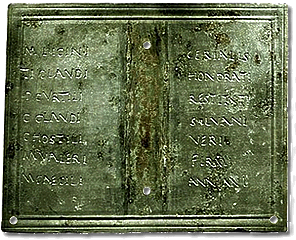
Bronze was used both by Greeks and Romans as material on which to engrave votive inscriptions, laws, treaties, and other solemn documents. These, however, do not come under present consideration, being strictly epigraphical monuments. The only class which we need notice is that of the Roman military diplomas, those portable tabulae honestae missionis, as they have been called, which were given to veteran soldiers and conferred upon them rights of citizenship and marriage. Fifty-eight such documents, or portions of them, issued under the emperors, from Claudius to Diocletian, have been recovered. They are interesting both palaeographically, as giving a series of specimens of the Roman rustic capital letters, and also for the form which they took, exactly following that observed in the legal documents preserved in waxen tablets (see below). They were, in fact, codices in metal. The diploma consisted of two square plates of the metal, hinged with rings. The authentic deed was engraved on the inner side of the two plates, and was repeated on the outside of the first plate. Through two holes a threefold wire was passed and bound round the plates, being sealed on the outside of the second plate with the seals of the witnesses, whose names were also engraved thereon. The seals were protected by a strip of metal, attached, which was sometimes convex to afford better cover. In case of the outer copy being called in question, reference was made to the deed inside by breaking the seals, without the necessity of going to the official copy kept in the temple of Augustus at Rome.
The repetition of the deed in one and the same diploma is paralleled in some of the Assyrian tablets, which, after being inscribed, received an outer casing of clay on which the covered writing was repeated.
↑top
Wooden tablets were used in very remote times. In many cases they were probably coated, if not with wax, with some kind of composition, the writing being scratched upon them with a dry point; in some instances we know that ink was inscribed upon the bare wood. The ancient Egyptians also used tablets covered with a glazed composition capable of receiving ink. 3 Wooden tablets inscribed with the names of the dead are found with mummies. They were also used for memoranda and accounts, and in the Egyptian schools; specimens of tablets inscribed with receipts, alphabets, and verses having survived to the present day. One of the earliest specimens of Greek writing is a document inscribed in ink on a small wooden tablet now in the Itrilish Museum (5849, C.); it refers to a money transaction of the thirty-first year of Ptolemy Philadelphus (B.C. 254 or 253). In the British Museum there is also a small wooden board (Add. MS. 33,293), painted white and incribed in ink with thirteen lines from the Iliad (iii. 273—285), the words being marked off and the syllables indicated by accents, no doubt for teaching young Greek scholars. It was found in Egypt, and is probably of the third century. There is also a miscellaneous set of broken tablets (Add. MS. 33,369) inscribed in ink on a giound of drab paint, with records relating to the recovery of debts, etc., at Panopolis, the modern Ekhmim, in the Thebaid; probably of the seventh century. In the records of ancient Greece we have an instance of the employment of wooden boards or tablets. In the inventory of the expenses of rebuilding the Erechtheum at Athens, B.C. 407, the price of two hoards, on which the rough accounts were first entered, is set down at two drachmas, or 9¾d. each : " σανίδες δύο ἐς ἃς τὸν λόγον άναγράφομεν." And again a second entry of four boards at the same price occurs. In some of the waxen tablets lately recovered at Pompeii, the pages which have been left in the plain wood are inscribed in ink. Wooden tablets were used in schools during the middle ages. In England the custom of using wooden tallies, inscribed as well as notched, in the public accounts lasted down to the present century.
↑top
Out we may assume that as a general rule tablets were coated with wax from the very earliest times in Greece and Rome. Such waxen tablets were single, double, triple, or of several pieces or leaves. In Greek they were called πίναξ, δέλτος, δελτίον, δελτίδιον, πυκτίον, πυξίον, γραμματεῖον ; in Latin, cerae, tabulae, tabellae. The wooden surface was sunk to a slight depth, leaving a raised frame at the edges, after the fashion of a child's school-slate of the present day, and a thin coating of wax, usually black, was laid over it. Tablets were used for literary composition, school exercises, accounts, or rough memoranda. They were sometimes fitted with slings for suspension. Two or more put together, and held together by rings acting as hinges, formed a caudex or codex. Thus Seneca, De brev. vit. 13 : " Plurium tabularum contextus caudex apud antiquos vocabatur; unde publicae tabulae codices dicuntur."
When the codex consisted of two leaves it was called δίθυροι, δίπτυχα, diptycha, duplices ; of three, τρίπτυχα, triptycha, triplices ; and of more, πεντάπτυχα, pentaptycha, quintuplices, πολύπτυχα, polyptycha, multiplices. In Homer we have an instance of the use of a tablet in the death-message of King Proetus, "graving in a folded tablet many deadly things. " And Herodolus tells us (vii. 239) how Demaratus conveyed to the Lacedaemonians secret intelligence of Xerxes' intended invasion of Greece, by means of a message written on the wooden surface of a tablet (δελτίον δίπτυχον) from which the wax had been previously scraped but was afterwards renewed to cover the writing. On Greek vases of the fifth and fourth ccnturies B.C., tablets, generally triptychs, are represented, both open in the hands of the goddess Athena or other persons, and closed and hound rouud with strings, hanging from the wall by slings or handles.
Tablets in the codex form would be used not only as mere note-books, but especially in all cases where the writing was to be protected from injury either for the moment or for a long period. Hence they were used for legal documents, conveyances and wills, and for correspondence. When used for wills, each page was technically called cera, as in Gaius, ii. 101: "Haec, ita ut in his tabulis cerisque scripta sunt, ita do lego."
They were closed against inspection by passing a triple thread, λίνον, linum, through holes in the boards, and sealing it with the seals of the witnesses, as will presently bo more fully explained. As to correspondence, small tablets, codicilli or pugillares, were employed for short letters ; longer letters, epistolae, were written on papyrus. Thus Seneca, Ep. 55, 11, makes the distinction : Adeo tecum sum, ut dubitem an incipiam non epistulas sed codicillos tibi scribere." The tablets were sent by messengers, tabellarii, as explained by Festus : " Tabellis pro chartis utebantur antiqui, quibus ultro citro, sive privatim sive publice opus erat, certiores absentes faciebant. Unde adhuc tabellarii dicuntur, et tabellae missae ab imperatoribus." The answer to the letter was inscribed on the same set of tablets and returned. Love-letters appear to have been sometimes written on very small tablets Martial, xiv. 8, 9, calls them Vitelliani. Tablets containing letters were fastened with a thread, which was sealed. The materials for letter-writing are enumerated in tho passage of Plautus, Bacchides, iv. 714: "Ecfer cito ... stilum, ceram et tabellas, linum"; and the process of sealing in line 748: " cedo tu ceram ac linum actutum age obliga, opsigna cito." In Cicero, Catil. iii. 5, we havo the opening of a letter: " Tabellas proferri jussimus. ... Primo ostendimus Cethego signum ; cognovit; nos linum incidimus ; legimus. ... Introductus est Statilius ; cognovit et signum et manum suam."
The custom of writing letters on tablets survived for some centuries after classical times. In the 5th century St. Augustine in his epistle to Romanianus (Migne, Patrolog. Lat. xxxiii. 80) makes reference to his tablets in these words :—"Non haec epistola sic inopiam chartae indicat, ut membranas saltem abundare testetur. Tabellas eburneas quas habeo avunculo tuo cum litteris misi. Tu enim huic pelliculae facilius ignosces, quia differri non potuit quod ei scripsi, et tibi non scribere etiam ineptissimum existimavi. Seel tabellas, si quae ibi nostrae sunt, propter hujusmodi necessitates mittas peto." St. Hilary of Arles likewise has the following passage in his Life of Honoratus (Migne, Patrol. Lat. 1. 1261) : —" Beatus Eucherius cum ab eremo in tabulis, ut assolet, cera illitis, in proxima ab ipso degens insula, litteras ejus suscepisset: ' Mel,' inquit, ' suum ceris reddidisti.' " Both these passages prove that the custom was general at the period. Even as late as the year 1148 a letter " in tabella" was written by a monk of Fulda.
It will be noticed that St. Augustine refers to his tablets as being of ivory. The ancient tablets were ordinarily of common wood, such as beech, or fir, or box, the " vulgaris buxus " of Propertius (iii. 23); but they were also made of more expensive material. Two of Martial's apophoreta are "pugillares citrei" and " pugillares eborei." Propertius (I.c.) refers to golden fittings: "Non illas fixum caras effecerat auram." The large consular diptychs, as we know from existing specimens, were of ivory, often most beautifully carved.
The employment of waxen tablets lasted for certain purposes through the middle ages in countries of Western Europe. Specimens inscribed with money accounts of the thirteenth and fourteenth centuries have survived to the present day in France ; and municipal accounts on tablets of the fourteenth and fifteenth centuries are still preserved in some of the German towns. They also exist in Italy, dating from the thirteenth or fourteenth century; they were used in England; and specimens are reported to have been found in Ireland. It is said that quite recently sales in the fish-market of Rouen were noted on waxen tablets.
↑top
Ancient Greek waxen tablets have survived in not many instances. In the British Museum are some which have been found in Egypt. The most perfect is a book (Add. MS. 33,270), perhaps of the third century, measuring nearly nine by seven inches, which consists of seven tablets coated on both sides with black wax and two covers waxed on the inner side, inscribed with documents in shorthand, presumably in Greek, and with shorthand signs written repeatedly, as if for practice, and with notes in Greek; in one of the covers a groove is hollowed for the reception of the writing implements. Another smaller book, of about seven by four inches, formed of six tablets (Add. MS. 33,368), is inscribed, probably by some schoolboy of the third century, with grammatical exercises and other notes in Greek, and also with a rough drawing, perhaps meant for a caricature of the schoolmaster. There are also two tablets inscribed with verses in Greek uncial writing, possibly some literary sketch or a school exercise. Two others of a similar nature have been recently acquired, the one containing a writing exercise, the other a multiplication table. The Bodleian Library has also lately purchased a waxen tablet (Gr. Inscr. 4) on which is a writing exercise. Others are at Paris; some containing scribbled alphabets and a contractor's accounts, which were found at Memphis. In New York is a set of five tablets, on which are verses, in the style of Menander, set as a copy by a writing-master and copied by a pupil. Other specimens of a similar character are at Marseilles, the date of which can be fixed at the end of the 3rd or beginning of the 4th century; and the last leaf of a document found at Verespatak, where so many Latin tablets have been discovered, is preserved at Karlsburg.
↑top
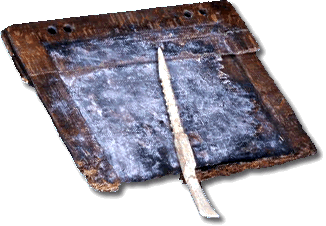
Extant Latin tablets are more numerous, but have only been found in comparatively recent years. Twenty-four, containing deeds ranging in date from A.D. 131 to 167, were recovered, between the years 1786 and 1855, from the ancient mining works in the neighbourhood of Alburnus Major, the modern Verespatak, in Dacia. In 1840 Massmann published the few which had at that time been discovered, in his Libellus Aurarius; but the admission into his book of two undoubtedly spurious documents cast suspicion on the rest, which were accordingly denounced until the finding cf other tablets proved their genuineness. The whole collection is given in the Corpus Inscriptionum Latimarum of the Berlin Academy, vol, iii.
During the excavations at Pompeii in July, 1875, a box containing 127 waxen tablets was discovered in the house of L. Caecilius Jucundus. They proved to be perscriptiones and other deeds connected with sales by auction mid receipts for payment of taxes.
The recovery of so many specimens of Latin tablets has afforded ample means of understanding the mechanicaI arrangement of such documents among the Romans, like the military tabulae honestae missionis, they contained the deed under seal and the duplicate copy open In inspection. But most of them consist of three leaves: they are triptychs, the third leaf being of great service in giving cover to the seals. The Pompeian and Dacian tablets differ from one another in some particulars; but the general arrangement was as follows. The triptych was made from one block of wood, cloven into the three required pieces, or leaves, which were fastened by strings or wires passing through two holes near the edge and serving for hinges. In the Pompeian tablets, one side of each leaf was sunk within a frame, the hollowed space being coated with wax in such a way that, of the six sides or pages, nos. 2, 3, 5 were waxen, while 1, 4, 6 were of plain wood. The first and sixth sides were not used; they formed the outside. On the sides,2 and 3 was inscribed the deed, and on 4 the names of the witnesses were written in ink and their seals sunk into a groove cut down the centre, the deed being closed by a string of three twisted threads, which passed through two holes, one at the head and the other at the foot of the groove, round the two leaves and under the wax of the seals, which thus secured it. An abstract or copy of the deed was inscribed on page 5. The Dacian tablets differed in this respect, that page 4 was also waxen, and that the copy of the deed was commenced on that page in the space on the left of the groove, the space on the right being filled with the witnesses' names. The following diagram shows the arrangement of a Dacian triptych :—

It will he noticed that, although the string which closed the deed (as indicated by dotted lines) passed through the holes of only two of the leaves, yet the third leaf (pages 5 and 6) is also perforated with corresponding holes. This proves that the holes were first pierced in the solid block, before it was cloven into three, in order that they might afterwards adjust themselves accurately. In one instance the fastening threads and seals still remain.
↑top